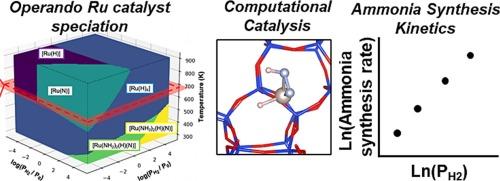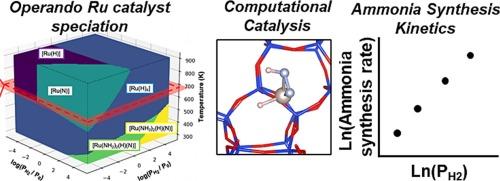Mechanistic insights into nitrogen activation on atomic Ru clusters in self-pillared pentasil using operando atomistic models and experimental kinetics
IF 6.5
1区 化学
Q2 CHEMISTRY, PHYSICAL
引用次数: 0
Abstract
Alternative catalysts to the industrial Haber Bosch process have been of significant interest in the field of heterogeneous catalysis, yet realizing ammonia synthesis under mild conditions (e.g., 300 °C and 10 bar) is challenging due to the low per-pass conversion. One strategy is to promote the associative ammonia synthesis mechanism which eschews direct N-N bond cleavage. Here we use self-pillared pentasil, a self-pillared hierarchical zeolite built by thin MFI zeolite nanosheets, as a support for subnanometric Ru clusters to synthesize ammonia. We show that Ru remains well-dispersed during reaction and further demonstrate that ammonia synthesis rates are higher than Cs-Ru/MgO. Reaction kinetics show a positive order in H2 providing evidence for the associative mechanism, which then becomes negative in H2 if Ru is allowed to aggregate into nanoparticles. Operando Density Functional Theory models for Ru speciation in SPP, free energy diagrams, and microkinetic modeling were then applied to develop a reaction mechanism that involves sequential hydrogenation of N2 from metallic Ru clusters. For this hydrogenation to occur, there are site requirements for N2 to adopt a bridge-bound configuration that facilitates sequential hydrogenation on single sites and metal clusters. These site requirements in turn inform the design of improved zeolite-supported ammonia synthesis catalysts.


利用操作原子模型和实验动力学研究自柱式五硝基中Ru原子团簇的氮活化机理
工业Haber Bosch工艺的替代催化剂在多相催化领域引起了极大的兴趣,但由于每道转化率低,在温和条件下(例如300 °C和10 bar)实现氨合成具有挑战性。一种策略是促进避免N-N键直接裂解的结合氨合成机制。在这里,我们使用自柱五柱沸石,一种由薄的MFI沸石纳米片构建的自柱分层沸石,作为亚纳米级Ru团簇合成氨的支撑。我们发现Ru在反应过程中保持了良好的分散,并进一步证明了氨合成速率高于Cs-Ru/MgO。反应动力学在H2中显示为正序,为结合机制提供了证据,如果允许Ru聚集成纳米颗粒,则反应动力学在H2中变为负序。然后,应用SPP中Ru形态形成的Operando密度泛函数理论模型、自由能图和微动力学模型,开发了一个涉及金属Ru团簇中N2顺序加氢的反应机制。为了使这种氢化发生,有场地要求N2采用桥键构型,以促进在单个位点和金属簇上的顺序氢化。这些场地要求反过来又为改进的沸石负载的氨合成催化剂的设计提供了信息。
本文章由计算机程序翻译,如有差异,请以英文原文为准。
求助全文
约1分钟内获得全文
求助全文
来源期刊

Journal of Catalysis
工程技术-工程:化工
CiteScore
12.30
自引率
5.50%
发文量
447
审稿时长
31 days
期刊介绍:
The Journal of Catalysis publishes scholarly articles on both heterogeneous and homogeneous catalysis, covering a wide range of chemical transformations. These include various types of catalysis, such as those mediated by photons, plasmons, and electrons. The focus of the studies is to understand the relationship between catalytic function and the underlying chemical properties of surfaces and metal complexes.
The articles in the journal offer innovative concepts and explore the synthesis and kinetics of inorganic solids and homogeneous complexes. Furthermore, they discuss spectroscopic techniques for characterizing catalysts, investigate the interaction of probes and reacting species with catalysts, and employ theoretical methods.
The research presented in the journal should have direct relevance to the field of catalytic processes, addressing either fundamental aspects or applications of catalysis.
 求助内容:
求助内容: 应助结果提醒方式:
应助结果提醒方式:


